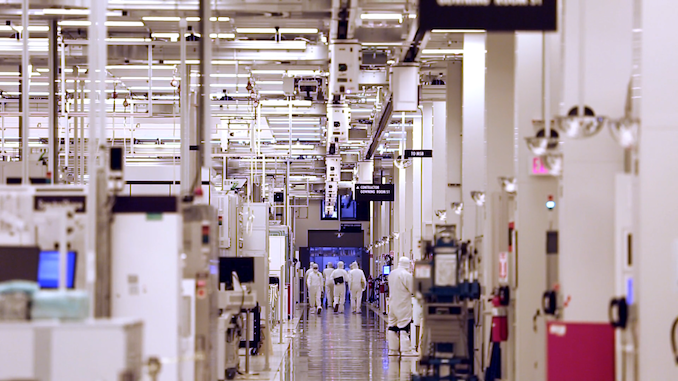Intel to Split Manufacturing Group into Three Segments
by Ian Cutress on October 17, 2018 11:25 AM EST- Posted in
- CPUs
- Intel
- Manufacturing
- TMG

News today from OregonLive, a reputable source on news out of Intel, has posted that Intel is set to reorganize its manufacturing group. Spurred by the retirement of Sohail Ahmed next month, who has led the group since 2016, the Technology and Manufacturing Group will be split between the Technology Development, Manufacturing and Operations, and the Supply Chain.
Intel’s delays in its 10nm process technology have been extensively discussed, although the reasons behind it have rarely been aired in public. The process technology was originally set to have been in production in 2016, and although Intel officially ‘shipped for revenue’ an obscure 10nm part in 2017, we are still waiting on the 10nm process to hit the primetime. Normally we expect to see a new major manufacturing process every 18-36 months, however the difficulties Intel has faced by attempting to implement a raft of new features down at the 10nm level have proved bigger than expected.
After the retirement of Ahmed, the full three groups will be headed up by different managers already at Intel:
- Technology Development, to be led by CTO Mike Mayberry*
- Manufacturing and Operations, led by Ann Kelleher
- Supply Chain, led by Randhir Thakur
*Mike Mayberry was the head of Intel Labs. Rich Uhlig will be the new interim manager for Intel Labs.
How the three groups will work together has not yet been determined. As this is still during the transition to 10nm, there could be additional challenges in splitting the groups. This is also on the back of Intel still not having a CEO, after Krzanich was removed earlier this year. Given Intel’s predicted six-month search for a new CEO, we should be hearing about it soon.
Source: OregonLive










41 Comments
View All Comments
Kvaern1 - Thursday, October 18, 2018 - link
Intel milked the cow to the bitter end, just like any other large corporation in a similar situation would do, but that being said Intel has also been seriously upgunning for a while now so I'd expect a pretty strong comeback.FullmetalTitan - Thursday, October 18, 2018 - link
100% accurate take. Intel has been bleeding talent for a couple years to all of the above. Management has been a major issue per some of those that jumped ship, and is holding them back from executing on the vision their engineers have.JKflipflop98 - Wednesday, October 17, 2018 - link
You couldn't be further from the truth. You obviously have no idea what you're talking about.HStewart - Wednesday, October 17, 2018 - link
Just keep in mind - AMD fans love to be one side and don't believe in improvement outside of Node side. Also don't want to believe that Intel 10nm is actually same as others 7nmThere is more that makes up a CPU than node size - I remember the days of Frequency wars - and it that case it was actually Intel with raising CPU speed.
sa666666 - Wednesday, October 17, 2018 - link
AMD was not mentioned once in this thread until you brought it up. You just can't resist bad-mouthing other companies when your precious Intel is being cast in a bad light.Look, Intel screwed up over the past few years. They got complacent and lazy. Not the first company to do it, and certainly not the last. Can you just accept that your company-worship looks extremely pathetic, and that Intel just made a mistake?? They can likely right the ship and come out of it, but your blind loyalty really makes you look like a clown.
Targon - Wednesday, October 17, 2018 - link
IPC, you missed that if IPC has not improved, then where is the "new generation" that shows the design, not fab process has been worked on? No higher clock speeds from Intel in a long time(outside of increasing base/turbo speeds to get closer to the true potential of the chips), no IPC improvements, so no better performance per clock. That is where people can fairly say that Intel hasn't done much to improve their chips in four+ years.peevee - Wednesday, October 17, 2018 - link
Clock increases are basically stuck since 4GHz Pentium 4s. There is no way around physics, power consumption=heat grows as square or faster with clock while performance less than linearly (near enough to process limits that is).Architecturally, the limitations of both increasing clock and Von Neumann-derived architecture were hit >10 years ago, and only density improvements with SMP on chip have kept them going - which are over at so-called "14nm" (14+ and ++ are less dense, and even 32, 22 and 14nm are not really 32, 22 and 14 in any sense, transistors are not even smaller than on 45nm node, just FinFET and more precise manufacturing enabled lower voltages for the same clocks and consequently thinner wires/denser packing).
A lot, a lot of BS was said by Intel marketing - but the truth (above) is simple.
FullmetalTitan - Thursday, October 18, 2018 - link
Clock speeds are gated by simple physics. RC delay is a bitchRSAUser - Thursday, October 18, 2018 - link
Intel 10nm is definitely not the same size as other 7nm and there is an article about it somewhere on anandtech.Their 14nm was better than the competition, their 10nm probably won't be.
ToTTenTranz - Wednesday, October 17, 2018 - link
I wonder how much of this surprise came from Intel counting on AMD to just stick with the lesser-competitive GlobalFoundries for CPUs until the end of times.Truth be told, if AMD was stuck with GF (and their constant inability to release top-end processes on time) then Intel would probably get another year or two with their 14++ vs. 12LP process advantage, and that could be enough to finally solve their 10nm problems.